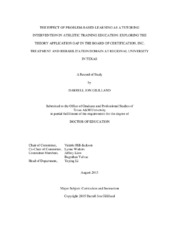| dc.contributor.advisor | Hill-Jackson, Valerie | |
| dc.contributor.advisor | Walters, Lynne | |
| dc.creator | Gililland, Darrell Jon | |
| dc.date.accessioned | 2015-10-29T18:50:24Z | |
| dc.date.available | 2015-10-29T18:50:24Z | |
| dc.date.created | 2015-08 | |
| dc.date.issued | 2015-06-05 | |
| dc.date.submitted | August 2015 | |
| dc.identifier.uri | https://hdl.handle.net/1969.1/155381 | |
| dc.description.abstract | The purpose of this study was to explore the effects of problem-based learning (PBL) as a tutoring intervention in narrowing the theory application gap within the treatment and rehabilitation domain of Regional Universities athletic training education program (ATE). Research indicates there are theory application gaps between didactic and practical applications in nursing, physical therapy, athletic training, and teacher education programs. This theory application gap exists when a transfer of knowledge breakdown occurs in the classroom and clinical practice integration. Students at Regional University in Texas have scored well below the national average in the treatment and rehabilitation domain of the Board of Certification, Inc. national certification examination.
Athletic students within the RU ATE volunteered for participation in the study and provided the sample of convenience (N=15). The sample size consisted of student cohorts from each academic level within the ATE: Level-I (N=5), Level-II (N=5), and Level-III (N=5). Students participated in the study for five-weeks during the spring of 2013. Students received an orientation to PBL during the first week followed by the PBL tutoring intervention in the subsequent weeks.
This study utilized a convergent parallel mixed methods design as the methodological framework. The Elizondo-Montemayor Criterion Reference (EMCR) self-assessment for PBL was utilized as the pre and posttest quantitative tool. Descriptive analysis was performed on the EMCR followed by the Kruskal-Wallis statistical analysis to and a post-hoc Mann-Whitney U analysis.
Qualitative data was collected using the transcripts from focus groups and student reflection journals. A constant comparative method of analysis was used to review data from the focus groups and reflection journals. The EMCR self-assessment PBL objectives guided the thematic coding process. Through the constant comparative method of analysis, sub-themes emerged in both the focus groups and reflection journals.
The results of the study indicate a statistical significance in the pre-posttest in the PBL objects of application of knowledge, clinical reasoning, and self-directed learning. However, the average self-directed learning EMCR score rated the academic levels as “poor”. Qualitative results corroborate the self-directed learning quantitative findings, students also perceived the theory application gap within ATE as one that hinders learning. | en |
| dc.format.mimetype | application/pdf | |
| dc.language.iso | en | |
| dc.subject | Problem-Based Learning | en |
| dc.subject | Theory Application Gap | en |
| dc.subject | Athletic Training Education | en |
| dc.subject | | en |
| dc.title | The Effect of Problem-Based Learning as a Tutoring Intervention in Athletic Training Education: Exploring the Theory Application Gap in the Board of Certification, Inc. Treatment and Rehabilitation Domain at Regional University in Texas | en |
| dc.type | Thesis | en |
| thesis.degree.department | Teaching, Learning, and Culture | en |
| thesis.degree.discipline | Curriculum and Instruction | en |
| thesis.degree.grantor | Texas A & M University | en |
| thesis.degree.name | Doctor of Education | en |
| thesis.degree.level | Doctoral | en |
| dc.contributor.committeeMember | Liew, Jeffery | |
| dc.contributor.committeeMember | Yalvac, Bugrahan | |
| dc.type.material | text | en |
| dc.date.updated | 2015-10-29T18:50:24Z | |
| local.etdauthor.orcid | 0000-0002-8263-8459 | |


